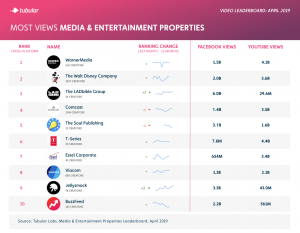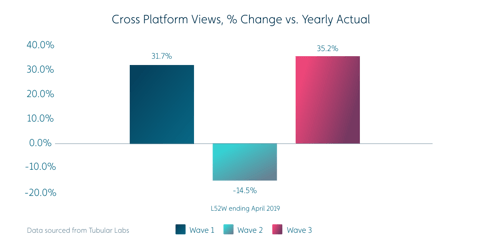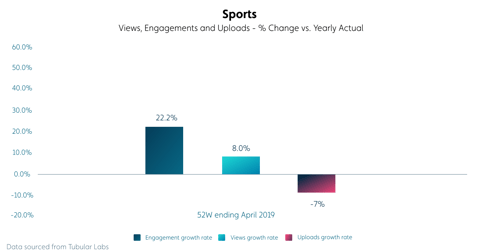Beyond the Highlight Reel
Why Audience-First Content is the Next Wave in Sports Media

By
![]() Team Hashtag
•
5 min read
Team Hashtag
•
5 min read
June 6, 2019
How a new wave of media publishers and brands are creating competitive advantages through deep fan engagement and agile content cycles in the world of sports and beyond.

Video is redefining sports entertainment… again
A few years ago, a new class of digital-first publishers, led by the likes of BuzzFeed and Bleacher Report, began rapidly growing audiences. They redefined entertainment for digital audiences and began fueling demand among content-hungry audiences for video experiences designed for consumption on platforms like YouTube and Facebook.
Today, incumbent broadcast and media companies are beginning to catch up, repositioning select linear programs for the digital-first consumption habits of their growing online audiences. Through sheer size and scale, many legacy companies today are successfully competing for the attention of online audiences (Fig 1).
If you’re in sports, this should come as no surprise. The sports vertical has historically experienced significant disruption, starting in the 80’s with the success of ESPN and the demand for 24-hour sports-based information. Back then, ESPN proved that there was an unmet demand for sports-related content, and as a result, changed the way people consumed the genre forever.
The recent explosion of digital video has given fans more touch points than ever before, allowing them to go beyond the barstool and highlight reels to remain connected with their favorite teams, celebrity athletes, and reporting channels. Accordingly, this group has different expectations for the types of content they are willing to engage with.
In order to be successful in this highly competitive marketplace, content producers must dial into these rapidly changing consumption preferences. One group (The Connectors) in particular has found new and innovative ways to grow more engaged, and therefore valuable, audiences with content that’s literally at their fingertips.
The who’s-who of sports entertainment on video
How have broadcasters and reporting channels taken sports entertainment beyond the collective watching experience and watercooler conversation of days past, into the current era of the always-connected fan? For simplicity’s sake, we can think of the evolution in three waves:
Wave 1, The Rights Holders. These are the content owners. They include networks like ESPN, Turner, Fox, NBC, CBS, and even the popular leagues themselves (NFL, NBA, MLB, etc.). Their video strategy typically tends to be repurposing game highlights and interviews.
Wave 2, The Reporting Channels and Content Creators. These are content producers and broadcasters and they are adept at translating traditional reporting methods to the digital-first world on social platforms. Properties like Bleacher Report, Whistle Sports, Sports Illustrated, Sporting News, and FanSided fall into this category.
Wave 3, The Connectors. This group is incredibly agile and skilled at connecting the dots between fans and their favorite teams by finding new ways to engage them (via cross-platform distribution and channel strategies). Think of them as the NowThis of sports, they optimize for digital-first consumption habits by repackaging and distributing content tailored for the always-connected fan. Examples include properties like WAVE Sports, Ball is Life, Oh My Goal, Overtime, and Barstool Sports.
In the last year, the reporting channels and content creators who once redefined the space, began to lose market share to the connectors (Fig 2). As a result, what was once the modernized underdog story has now become a cautionary tale: either give people what they want, where they want it, and fast, or risk becoming lost in the highly competitive content marketplace.
But don’t fret! By leaning into changes in consumption habits and attention spans, and not remaining ingrained in traditional ways of distribution The Rights Holders and The Reporting Channels and Content Creators have unlimited opportunities for engagement. After all, their inherent advantages as right’s owners and creators allow them to be more agile and responsive to their audiences.
You’d think with 18 years worth of video uploaded every day, fans would have the sports content they are seeking – but based on our analysis of how viewership has grown versus new videos coming online, this isn’t true. Today’s sports audience is actually being underserved (Fig 3).
There is room for more media companies and marketers to capture audience attention, provided they know how. The first step starts with developing audience-first content strategies just like The Connectors (Wave 3) have mastered.
Start with knowing your audience
What does differentiation in video look like, and how do you create authentic experiences that fans will resonate with? For starters, it means breaking away from the same narratives and not sharing the same 10 pieces of content that are being pushed every day.
As organizations invest more in video content, its very easy to fall into the trap of pursuing the next viral hit. But trend-chasing without understanding why a particular piece of content was successful, is essentially like going into an elimination game without a game plan against a red hot team. You may get lucky and win, but most likely, you’re going to lose.
Get Hashtag Sports in Your Inbox
Learn how to connect with the next generation of sports fans
In order to drive success, content owners and producers need informed content strategies to find the unique perspectives and moments people usually don’t see. You need to know where your audience is and what they are watching. This will allow you to stay on-screen, in front of your audience, and ahead of the curve. Using Audience insights, you’ll be able to:
- Uncover which videos perform (and why) in order to reach beyond typical social analytics and drive consistent, predictable performance
- Determine the variables that define your audience and what (else) they watch
- Benchmark your content against competitors
Doing the above you’ll be able to quickly identify the topics and white spaces that appeal to your audience and drive your content strategy. This can also help content creators build out distributed network and use social platforms to test new audiences. You might also use these tactics to identify additional new partners that fit with your audience, at the right level of ROI. For example, by using athletes as activation channels, or leveraging niche content creators to quickly scale content to underserved audiences.
The Colorado Rockies are honing in on effective visual storytelling in order to successfully reach the modern fan.
Read More
The latter concept was introduced by the Connectors, and it is a quick way to build and leverage an organically seeded content community that provides authentic experiences like no one else can. It works by identifying creators have the right voice for the underserved community and teaming up with them to build a channel up from scratch. Properties/channels can then use their “platform” as a distribution model.
On the importance of measurement
Up until this point, we’ve discussed how to create really engaging content by developing an audience-first content strategy. But in such a competitive content marketplace, that’s not always enough. The highest performing content teams regularly assess performance to scale and operationalize their outfit, and you should too. As a result, they are able to consistently realize ROI from content production.
The core to measurement and understanding content performance is being able to answer the question “what does good look like?” To do so, you have to extend beyond benchmarking your own content’s performance, and look around at other publishers, brands, influencers and athletes who are vying for the attention of the same audience.
We suggest using centralized dashboards to help manage and your content measurement initiatives, but you know what else would help? Measurement standards… After all, why compare the latest Champions League highlights to a video published at the beginning of the tournament, which will naturally have a thousand view head start?
Conclusion
We live in competitive times, but competition also fosters innovation. Trends will come and go, but our advice is simple: always approach content from an audience-first, platform-specific perspective. It’s easy to become single-sighted in pursuit of content nirvana, but don’t forget to look beyond your own content to your competitors, creators, and even influencers. They might just be on to the next big idea, and your audience is watching.

As SVP of Sales, Ken Holmes has leveraged his wealth of knowledge and experience in value selling approaches at Tubular Labs to find and partner with influencers and optimize content strategy and media planning to empower over 6,000 video creators and 100+ enterprise customers.


